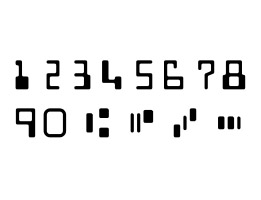How one partner used ocean freight to provide cost-effective delivery and gain a happy customer
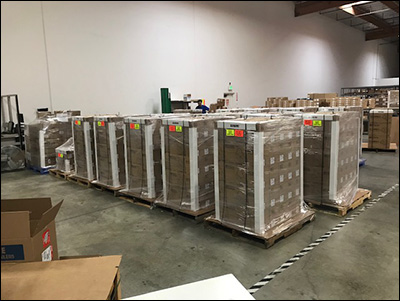
Part of the recent order of TS240 scanners for Albertsons awaits shipment to Chennai, India, from the Digital Check warehouse. |
Earlier this month, we had an opportunity to document an unconventional, but semi-frequent, occurrence at our manufacturing plant: Shipping an order for a full sea container of TellerScan TS240 scanners. This delivery went from our manufacturing plant in Southern California to our partner Albertsons International in Mumbai, with stops along the way in the Indian cities of Chennai and Bangalore.
With international orders, shipping can be a huge part of both the total price and the time to complete a project – but when executed correctly, it can make the difference between a deal that is on time and under budget, or one that is inconvenient and expensive for the customer.
Delivery by ocean freight is something that takes a serious level of commitment, both from ourselves and from the partner. There are a few prerequisites; namely, a large order size and certain logistical knowledge (with which Digital Check is more than willing to provide assistance). This particular order was actually Albertsons’ third full sea-container shipment in the past year, so they have gotten quite good at taking advantage of the opportunities it has to offer!
Obviously, shipping by sea is not for everyone, and it’s only practical in certain situations. Nonetheless, it IS a service that we are able to provide for our customers and partners – so we wanted to make you aware of it, as well as take this opportunity to look at the process a little more closely.
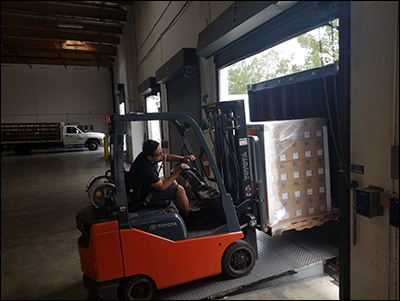
The order is loaded into a container for shipment. Yes, Digital Check can load full sea containers directly at our manufacturing plant, and have them shipped anywhere in the world! |
Sadly, many companies simply outsource international shipping, or go with the easiest option – and then either pass on their higher costs to the customer, or cut corners on quality and service. We’ve come to learn that being on top of your logistical game is often the tipping point between a happy customer and an angry one.
Digital Check operates its own manufacturing facility and warehouse capable of sending freight shipments of any size, anywhere in the world – and we’ve been selling our products overseas for more than 50 years. (If you’re used to dealing with companies that are afraid to “get their hands dirty,” you haven’t been dealing with us!)
With that in mind, let’s take a look at some of the factors that come into play when deciding whether ocean freight is an option:
Cost of Air Freight vs. Ocean Freight
One commonly held belief among those getting into international business is that air freight is prohibitively expensive under all circumstances. While this is certainly true for large-scale bulk shipments, it’s actually surprising how much you can ship by air before the price surpasses the flat costs that come along with ocean freight.
Going into the full details would take far more space than we have (for an excellent in-depth breakdown of air vs. sea freight costs in layman’s terms, click here). For our purposes, the gist of it is: Orders of 100 scanners or less are almost certainly less expensive to send by air, due to the fixed costs of ocean freight. If you have a couple hundred scanners, you might save a little bit with sea shipping, but it may not be enough to make up for the added trouble. If we’re talking 500-plus devices, then ocean freight is worth a serious look.
Planning Around Longer Shipping Times
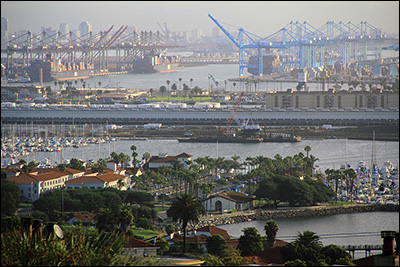
Digital Check’s warehouse is located within an hour’s drive of the Port of Los Angeles (above), as well as the Port of Long Beach. We frequently use either port, for both incoming and outbound shipments. (photo credit: Green Fire Productions / Creative Commons 2.0) |
Obviously, the other big consideration with ocean freight is time. While air cargo can generally be delivered anywhere in the world within a week, it might take one or two months if you send it by ship. What’s more, a sea shipment doesn’t necessarily have a fixed delivery date; and even if it does, it’s common for that to change. Weather conditions, wait times at the port, customs clearance, or any number of similar issues can affect the arrival date several times while the goods are in transit.
So far, it might seem like all this is more trouble than it’s worth – but that’s where a little planning makes all the difference. When we get an order for a large sea shipment, we’ll help with the project management part of the deal, because there’s a lot more to it than just getting boxes onto a boat.
Let’s take a look at what that meant for our partner Albertsons and their shipment to India. The most recent order actually represented the initial deliveries for three separate banks, who were all kicking off teller window updates. As explained by Ninad Chavan, our regional manager for the India subcontinent:
A longer lead time for sea consignment means a shorter time for in-country deployment once the shipment arrives. Customers can be convinced to wait for a delivery to the extent that it reduces their own costs – and in fact, we encourage our partners to bring up the ocean freight option, rather than simply passing higher logistics costs on to the customer by default. People appreciate it when you are looking out for their best interests, and this is also a way to gain a competitive edge by keeping costs down.
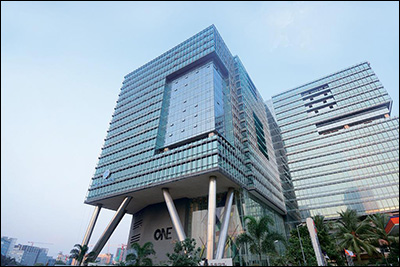
Albertsons’ headquarters is in the One BKC building, overlooking the Mumbai Cricket Grounds. |
But – and this is a big “BUT” – everyone has a limit to their patience. If you make promises that you can’t deliver, or if you don’t know what you’re doing, then they won’t want to keep doing business with you. So, planning everything out well in advance, and delivering the goods promptly once they’ve arrived in the country, are of the highest importance.
We have to bring in process efficiencies, along with our partner, to optimize the time to market. While air cargo gives us breathing space for on-the-ground deployment, the sea cargo eats up a lot of time up front. This project involved several key steps:
- Meetings with the banks and negotiating the project/deployment timelines.
- Prioritizing: Working with banks in prioritizing key branches to be deployed first, followed by the other segments.
- Identifying risks and having a Plan B, in case Plan A is postponed or delayed. In other words: Sea shipments do not necessarily have fixed delivery dates, and these can easily get delayed – international holidays, busy ports, weather conditions, geopolitics, and so on, can all create a bottleneck. For such scenarios, we have to keep a Plan B ready. One way of doing this is by keeping emergency inventory on hand in the country.Having a small number of scanners available can be enough to take care of urgent deployments and allow us to buy more time in the event that the main shipment is delayed. Many of our long-time partners and distributors do maintain a small stock of scanners already, to be used as replacements for devices being repaired, or as “safety stock” for unforeseen orders that are time-sensitive. This practice is highly recommended for anyone considering a large order by ocean freight. Otherwise, another way to safeguard against unexpected delays would be to send part of the shipment ahead by air freight – although this can become expensive.
- Having a communication plan, query handling, and resolution throughout the project lifecycle. The customer simply feels better when they can get a hold of someone to handle issues, real or perceived, while waiting for the shipment to arrive. Keeping in regular contact also helps both the partner and the customer be ready to “hit the ground running” when the delivery finally arrives.
- Having the resources available for speedy local transportation and deployments once the shipment arrives in-country. A lot of people who are doing this for the first time think they can relax once their ship comes in, but it’s more like the opposite!
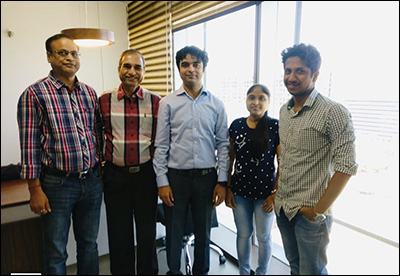
Digital Check’s regional manager for India, Ninad Chavan (center), in Mumbai with the Albertsons team members during a meeting at BKC One. From left to right: Yogesh Shah, Victor Sequeira, Ninad Chavan, Fouziya Shaikh, and Vinay Yadav. |
Once the cargo is off the boat, we typically work with an import/export agent to clear the shipment through customs, with freight carriers to get the cargo from the port to the Albertsons warehouse in Bangalore, and then again for final delivery to the customer. Then we needed to coordinate a team of technicians to help with the deployment, testing, and on-site integration and training as the deliveries were made. All of this was ready in advance, so that we could have the first wave of installations up and running within a matter of days.
Adding to the complexity of the project, this particular shipment had to be sent through the port in Chennai, not Mumbai where our partner is based, and much of the process had to be arranged remotely. But this was not our first sea shipment to India, nor was it Albertsons’ first full-container order; we’ve both handled deliveries through the Chennai and Mumbai ports before. Past experience holds a lot of value when it comes to things like this!
The last-leg deployment is something that simply cannot be overlooked – this container order involved managing deployment to hundreds of branches spread out over more than 25 different provinces of India. (There are 29 provinces and 7 territories within India, so this basically means it was spread across the entire country!) All of this had to take place within a matter of a few days as part of the commitments to the customers up front.
Once the scanners reach the port we (DCC+Albertsons) have to ensure that we deploy these scanners at the branches that are spread across the country in record times. This is part of the last leg deployment commitments we have given to the banks. This particular order involved managing deployment of 500 different branches spread across more than 25 different provinces within a span of few days.
(front photo credit: Ingrid Taylar / Creative Commons 2.0)

